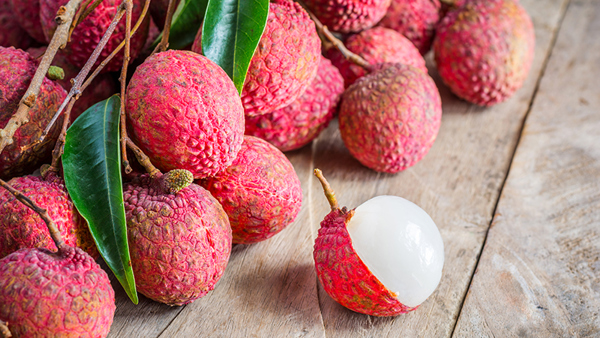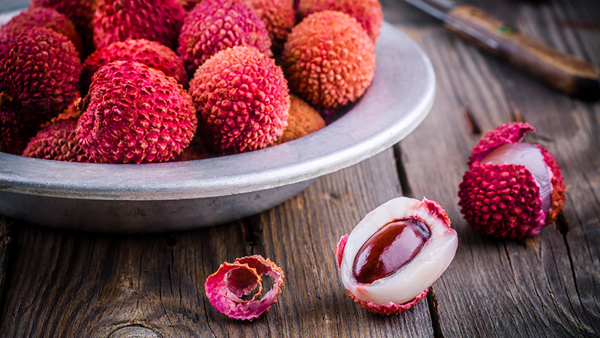Yates Account
Join now
Create a Yates account today!
Sign up to join the Yates Garden Club for monthly e-mails packed with seasonal inspiration, tips for success & exclusive promotions.
Plus if you’re a Garden Club member you can take part in the Yates Growing Community - a blog to share successes, get advice & win prizes in fun challenges along the way!

Forgot password
Enter the email address associated with your account, and we'll email you a new password.

They say good things come in small packages - and that’s certainly the case for lychees (Lichi chinensis)! The flesh of this small red tropical fruit is wonderfully sweet and oh-so moreish. The trees make beautiful garden features too, reaching heights of 2-5m (or taller, if left unpruned) and will happily grow in tropical, subtropical and warm temperate regions. You’ll have to be patient though, as trees can take up to 4 years to fruit.
How to grow Lychees in a garden
- Choose a sunny spot with well drained soil. Enrich the soil with Yates Dynamic Lifter Organic Plant Food.
- Check the soil pH with a soil pH test kit. Lychees prefer a slightly acidic soil between 5.0 and 6.0. If the pH is higher than 6.0, to lower soil pH apply Yates Soil Acidifier Liquid Sulfur.
- If planting bare-rooted plants, remove plastic and soak roots in a bucket of water for 30 minutes prior to planting. If planting from a container, remove the plant from the container, gently tease the roots and cut away any circled or tangled roots.
- Dig a planting hole twice the width of the rootball and to the same depth. Position plant in hole and backfill with soil, gently firming down. Form a raised doughnut shaped ring of soil around the outer edge of the plant's root zone. This helps keep water where it's needed. Always water in well after planting to settle the soil around the roots.
- Mulch around the base with organic mulch like bark chips, woodchip or pea straw, keeping it away from the trunk.
- Water deeply, once every 2-3 days, depending on weather conditions. Once established, water deeply once every week.
- During the growing and flowering/fruiting season, feed with Yates Thrive Citrus & Fruit Granular Plant Food. Throughout the year, apply Yates Thrive Natural Fish & Seaweed+ Plant Food Concentrate.


How to grow Lychees in a pot
- Choose a pot at least 400mm wide and as deep. Position in full sun and protect from strong winds. Fill pot with a premium potting mix such as Yates Premium Potting Mix.
- If planting bare-rooted plants, remove plastic or hessian and soak roots in a bucket of water for 30 minutes prior to planting. If planting from a container, remove the plant from the container, gently tease the roots and cut away any circled or tangled roots.
- Position plant in centre of the pot, backfill with potting mix, gently firm down and water in well.
- Water deeply, once every 2-3 days, depending on weather conditions. Once established, water deeply once every week.
- Lychees prefer a slightly acidic mix between 5.0 and 6.0. To acidify the potting mix, apply Yates Soil Acidifier Liquid Sulfur.
- During the growing and flowering/fruiting season, feed with Yates Thrive Citrus Liquid Plant Food. Throughout the year, apply Yates Thrive Natural Fish & Seaweed+ Plant Food Concentrate.
- Each year, check to see if the plant needs potting up to a larger size - ideally at the end of the fruiting season, in early to mid autumn.
Growing tips
-
They are self-pollinating, so you’ll only need one tree to produce fruit.
- Prune after harvesting to help maintain shape.
- If your tree isn’t very productive after 5 years, it may well be that it’s not suited to your climate. Lychees need a good period of cool nights to a good balance of male and female flowers.
- Don’t pick lychees too early, they will turn brown and not ripen.
- Harvesting ripe lychees early morning and storing them in the fridge will help keep them fresh and hopefully, blemish free!
More Plants
Olive trees make beautiful specimen trees, screening plants or as a feature in a pot. The pickled fruits are delicious and are used in various dishes.
Grapefruit
Red or yellow and sometimes even pink, grapefruit are a great addition to your garden and plate. An excellent source of vitamin C and super tasty too!
Grapes
Grapes are easy to grow, provided you have space and a support to grow on. Eat them either fresh, dried, or frozen and blended into an icy drink.
Pear
Pear trees are superb fruit-bearing feature trees (up to 6m). Dwarf forms (up to 2m) are also available which are great for small gardens and pots.
Yates Thrive Citrus & Fruit Granular Plant Food
Fast acting, gradual feeding plant food specially formulated to grow citrus & fruit trees, with high potassium for more abundant fruit & added magnesium to help prevent leaf yellowing.
Yates Thrive Citrus Liquid Plant Food
Provides your citrus trees with the balanced nutrients they require for healthy growth, fruit production and development.
Yates Soil Acidifier Liquid Sulfur
Lowers the pH of soil - required when growing acid loving plants such as camellias, azaleas, rhododendrons, magnolias and blueberries.
Yates Dynamic Lifter Organic Plant Food
Releases nutrients slowly, improves the structure and moisture retention of the soil and encourages earthworms and beneficial soil micro-organisms.
















Share
Share this article on social media